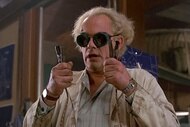Create a free profile to get unlimited access to exclusive videos, sweepstakes, and more!
Candyman's Vanessa Estelle Williams built a bridge between two generations of horror

When Vanessa Estelle Williams learned that producer Jordan Peele — the Oscar winner behind horror hits like Get Out and Us — was working on a new version of Candyman, the film she'd starred in all the way back in 1992, she knew immediately she wanted to be a part of it. What she didn't know was that while she was urging her agent to reach out to Peele on her behalf, Peele was already preparing to extend an invitation to have her involved.
"So it was just perfect harmony because I felt like, 'Aren't they going to need to use some of the survivors of the [original] film?'" Williams told SYFY WIRE.
**Spoiler Warning: There are spoilers for Candyman below.**
As Anne-Marie McCoy, a resident of the Cabrini-Green housing projects in the original 1992 film, Williams was indeed one of Candyman's most prominent surviving characters. Given the growing list of legacy horror sequels that revisit characters and locations from classics of decades past, it was easy to imagine a Candyman film in which Williams returned with a meaty cameo or another supporting role. What she ultimately got, thanks to director and co-writer Nia DaCosta, co-writer and producer Win Rosenfeld, and Peele, was a role that makes her the direct bridge between the events of the new film and the events of the old.
"So little did I know that Anne-Marie and her son Anthony would be so integral in terms of the way of connecting the films and the way into the film, in this incarnation of it. So I was overjoyed," Williams said.
She continued, "And it's very rare that one gets to take another look at the trajectory of what's happened to the character since we last saw them. And so it was just marvelous, a full circle moment in my life and in career. Candyman was the second feature film I'd ever done and the first film I'd done [after] landing in Hollywood, so it was pretty awesome, getting to look at it from that perspective as well."
For some viewers with a strong working memory of Candyman lore, the link between Williams and the film's lead character, Chicago artist Anthony McCoy (Yahya Abdul-Mateen II) was probably apparent in the opening minutes of DaCosta's film. For more casual fans, though, it doesn't really sink in until later in the film, when after frequently insisting that he grew up somewhere else, Anthony discovers that he was, in fact, born in the hospital closest to Cabrini-Green. This leads Anthony, already suffering from the effects of Candyman's slow infestation of his body, to confront his mother Anne-Marie, who's kept the secret of her time in Cabrini-Green from him for decades.
For Williams, developing the more mature version of her character began, appropriately, with her own experience in motherhood.
"I was able to look at it from a mother's point of view. And when I did the film I didn't have any children at that point," Williams said. "There were so many parallels, in terms of just the emotional sort of parallels that I had with Anne-Marie: Knowing what it's like to be a mom, and what it was like to be the mother of an artist, wanting to keep your children safe, having two Black sons to keep safe in this world. All of those things aligned perfectly."
Though her physical presence doesn't run through the entire film, Williams' participation in Candyman lends it even more of a sense of reverence to the film that came before it, something already apparent in many of DaCosta's visual choices, as well as the film's script. Anne-Marie's backstory — a mother who had her child taken, only to be reunited with him, in the end, thanks to a dying Helen Lyle (Virginia Madsen) — is emphasized so as to set up her reunion with Anthony.
While she noted she didn't rewatch the original film in preparation to reprise the role of Anne-Marie, the emotional context of where she left her character lived within Williams as she readied for her return.
"I think about the trauma of your child being taken, and then being returned to you, and then having the wherewithal and the humanity to forgive this person who's come into your life and caused all of this kind of cycle of events to go on," she recalled. "And then [to] have the humanity to forgive them and show up at Helen's funeral leading the whole contingency of the community there. I just think it spoke to just what kind of legacy and what kind of character Anne-Marie has."
Of course, Anne-Marie's character also includes her very clear choice to hide her son away from his true Cabrini-Green legacy, something that comes back to haunt her as Anthony returns and reveals that Candyman's presence is moving through him. Though it's Williams' only scene in the film, it's among Candyman's meatiest, as she and Abdul-Mateen had to navigate the powerful emotional landscape of that confrontation under DaCosta's directorial eye.
"Then you show up on set and you've got Nia at the helm, who's created this kind of respectful, warm, nurturing, very calm but fun, not intense kind of a set," Williams recalled. "It starts from the top, what kind of captain there is of the ship. And so everyone's there bringing their A-game, and then to work with Yahya who's so in the depth of where his body and his mind and his whole life is being turned inside out. I mean, it's showing up literally on his skin. He's literally turning into this other kind of being.
"So I just needed to have all that I had brought and just let that magic happen, because everyone's prepared. And then what every actor wants, and certainly I do when I come to set, is to have a director with a vision, with great communication skills, that allows you to find the scene and also then make it even better. It's a third eye that you can trust, and Nia had all of that. And so I just felt really safe and able to do my best. And I was very, very pleased with her choices."
DaCosta's new vision for Candyman explores a great many things with its re-examination of the franchise's lore, including the revelation that the figure known as "Candyman" is not one man, but an entire legacy of violence perpetrated against Black men, existing as a supernatural reminder of that violence and its consequences. Unfortunately for Anne-Marie, Anthony becomes prey to that same cycle in a very different, very brutal way by the end of the film. While her character doesn't see it, Williams did feel those connections deeply in reviving the character for the new film. In her sole scene with her son, as she and Abdul-Mateen felt out the right approach for the confrontation, she dug deep into the heartbreaking, human horror at the core of the film.
"We did the scene a number of different ways. We followed a maternal instinct to just be all up on your son and close to him, and trying to repair and check out what's going on with the skin and his face and all of this stuff," Williams recalled. "And then [I was] also taking the direction to take that in and then separate and see him as an adult and really make the confession and try to plead your case, where it's like, 'This is why I made the choices that I made, son, and try to understand me as one adult to another. And how do I warn you?' Anne-Marie's subtext is like, 'How could I warn you when this was a possibility I never wanted to happen? This was the very thing I was trying to protect you from, and I don't know how this cat got out the bag, literally.' So it just becomes so, so soul ripping that she's there having to explain her lie and having not been able to protect her child."
Candyman is in theaters now. For more on the film and its themes, check out the Candyman Social Impact Initiative on the official movie website.
(Universal Pictures — the studio behind Candyman — & SYFY WIRE are both owned by NBCUniversal)

























